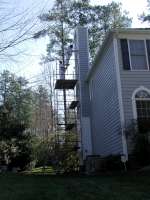SIDING, EXTERIOR REPAIRS AND TRIM
Siding is the outer “shell” of the home, it protects the building from sun, wind and rain. But as it covers most of the home's exterior it also becomes the main feature oh home's design. From stern and rustic stained wood siding to lively colors of vinyl siding to whimsical shakes – the choices are numerous. Here we will discuss advantages and disadvantages of most common types of siding for use in Durham, Chapel Hill and Hillsborough area from the standpoints of durability, appearance, maintenance and cost. Trades of the Triangle install most kinds of siding and exterior trim – give us a call.

Fiber cement siding
Fiber cement siding has evolved from asbestos paneling, which was manufactured and used until the late 1980s. It is also often called Hardi-board, owing this name to James Hardie Corporation - one of the prominent manufacturers of this type of siding. It no longer contains asbestos, which was linked to serious health problems, and technical advances made in the past decades have made it a excellent choice for home's exterior. Fiber cement is extremely durable and impact resistant once it's installed, although handling it prior to installation requires caution as long boards can break quite easily. It is also well-suited for humid summers we have here, in Chapel Hill, Durham and Hillsborough area. Fiber cement siding typically comes pre-primed, although some manufacturers offer it pre-painted as well and guarantee the finish to last for considerably long time. Fiber cement siding requires little maintenance other than power washing and painting. Most of the time this type of siding meets door and window frames, corner boards and other exterior trim components with a “butt” joint. These joints have to be thoroughly sealed and periodically maintained to prevent water penetrations in these areas. Fiber cement siding manufacturers offer a good variety of styles. It comes as horizontal lap boards in variety of widths and styles, as 4'x8' panels, simulated shakes and shingles and so on.
Fiber cement siding works and looks great on any type of building and is a excellent choice for re-siding projects and remodeling. It is heavy; you can expect regular 12' board to weigh close to 20 pounds and it gets much heavier if you are dealing with 4'x8' panels. Installation of fiber cement siding usually takes at least two people and three for production work. Cement dust produced from cutting siding can be harmful to respiratory health and care should be taken to avoid breathing it. Respirator mask and goggles are required and special low-dust blades are recommended for cutting.
Vinyl siding
Vinyl siding is probably the most affordable choice that can be made for home's exterior both in terms of material cost and installation. Vinyl siding will typically be installed by highly specialized vinyl siding contractors as this type of siding has very little to do with standard carpentry skill set and tools. Vinyl siding does it's best when installed into an integrated J-channel on specifically designed vinyl windows. It is possible to make it work with a wood window, too, but special care would need to be taken to prevent water from getting behind siding components. Because of this vinyl siding may not be the best choice for a remodeling project.
Vinyl siding is quite durable, but can becomes somewhat brittle after years of exposure. It is very easy to maintain, periodical power washing is sufficient to keep it looking new for many years. Due to it's being impervious to water, vinyl siding is well suited for installation in Chapel Hill, Durham and Hillsborough area.
There is a variety of available colors and few different designs give some room for applying your design ideas. Vinyl siding is not paintable, so choose your color carefully. Some manufacturers offer styles of vinyl siding which have appearance of cedar shakes, so standard horizontal lap doesn't have to be your only choice if you decide to settle on vinyl.
Wood siding
There is much to be said about aesthetic advantages of natural wood siding. Previously the only available option, it is very commonly found on older homes. Wood siding had also seen a revival in the 70-ies and 80-ies, when many a home were built to then-popular passive solar energy-efficient specifications and sided with cedar or rough-sawn pine.
Because wood is susceptible to decay, special care should be taken to protect it from prolonged contact with water, especially on the north side of the house. Pre-finishing on all sides prior to installation, healthy margis between siding and roofing, thoroughly designed flashing, well-performing gutters and keeping bush and tree branches from touching the walls are all important factors to ensure longevity and performance of the wood siding. Both cedar and pine siding in our Hillsborough, Chapel Hill and Durham climate require more involved maintenance than other types of siding.
Owners of homes with old painted wood siding often face a quandary when re-painting since new EPA lead paint rule went into effect a few years ago. It is no longer allowed to sand, grind or heat old lead paint. Old flaking paint can only be manually scraped – and that under very stringent rules by trained and certified companies. The rule makes routine exterior preparation of such homes exceedingly cumbersome and expensive, when done in compliance.







